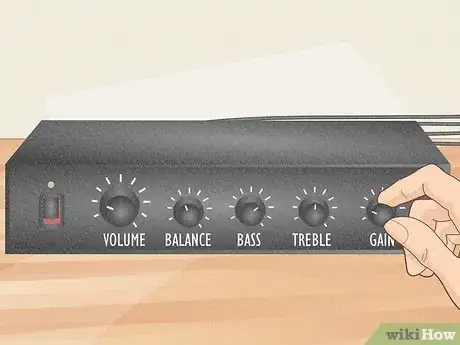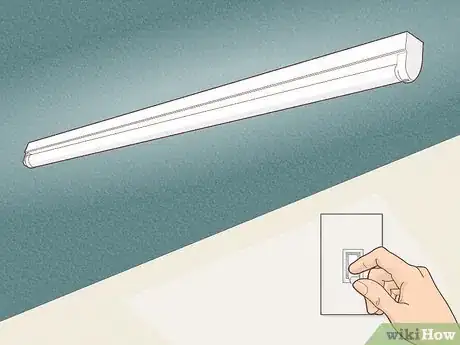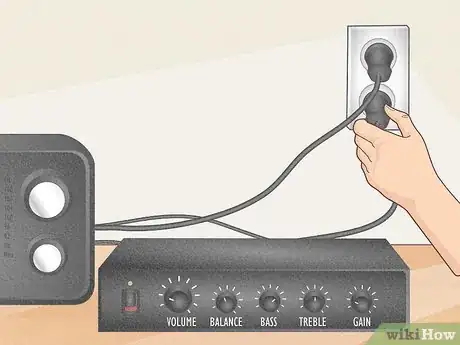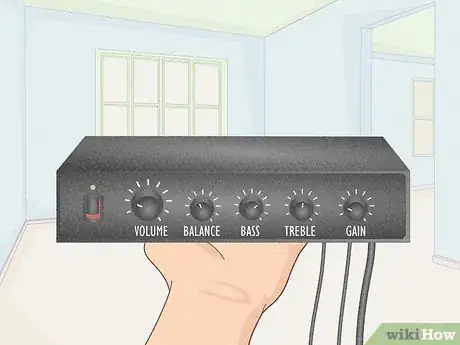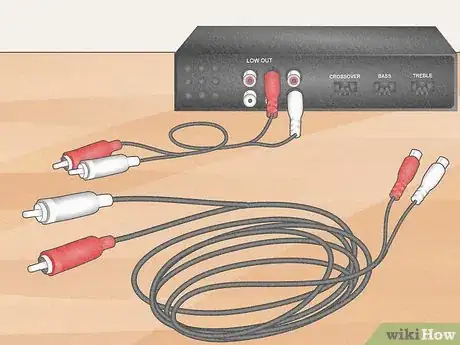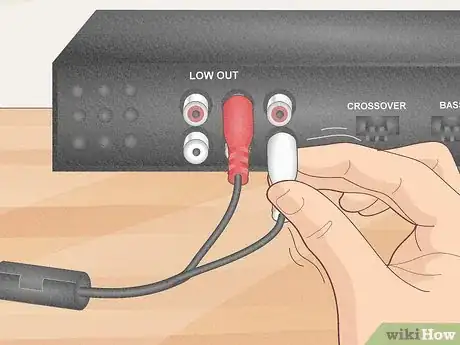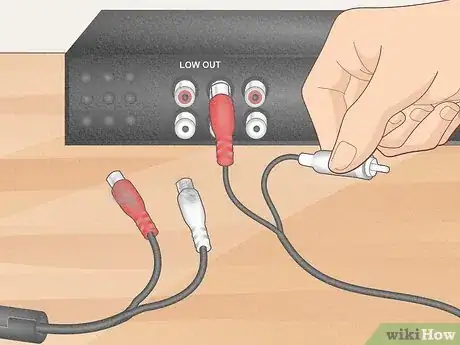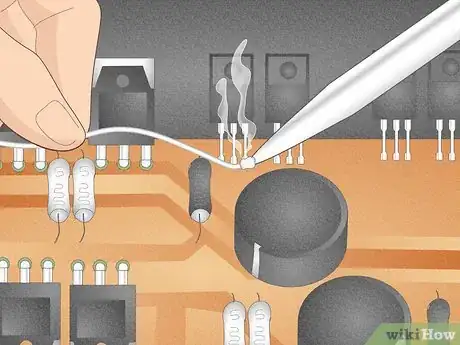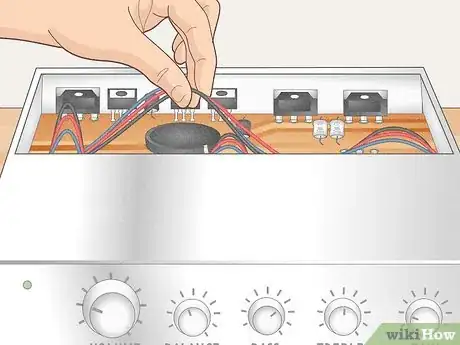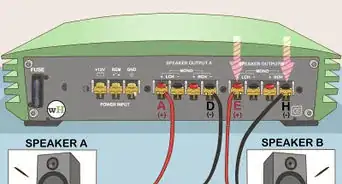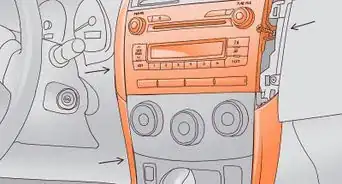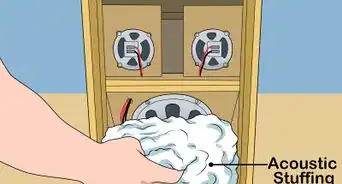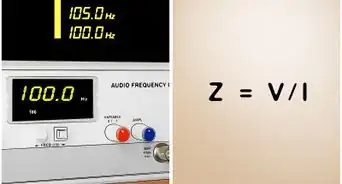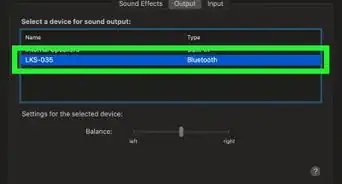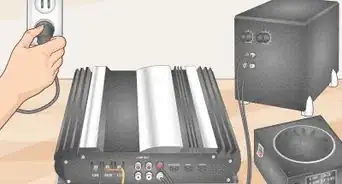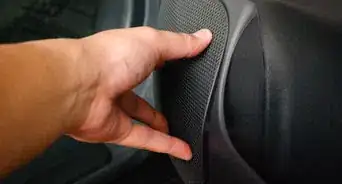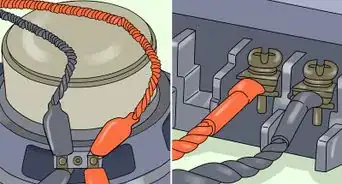This article was co-authored by wikiHow staff writer, Hunter Rising. Hunter Rising is a wikiHow Staff Writer based in Los Angeles. He has more than three years of experience writing for and working with wikiHow. Hunter holds a BFA in Entertainment Design from the University of Wisconsin - Stout and a Minor in English Writing.
There are 10 references cited in this article, which can be found at the bottom of the page.
This article has been viewed 40,999 times.
Learn more...
It can be really annoying when you plug into an amplifier and it starts humming. Unwanted feedback from your amp can be caused by bad wiring, radio interference, or loose connections between your equipment. Luckily, there are a few things you can try to help reduce or completely eliminate the constant hum. Once you fix the source of the hum, your amp will have clear and crisp audio!
Steps
Limiting Interference
-
1Lower the gain setting on your amp for the easiest solution. The gain setting increases the strength of the amp’s signal, which effectively makes the audio louder. Find the dial labeled “Gain” on your amp’s control panel and turn it counterclockwise. Keep turning the dial until you don’t hear the humming sound coming from your amp anymore.[1]
- If you still hear the amp humming, then there may be an issue with the wiring or the equipment the amp plugs into.
-
2Turn off fluorescent lights and other interference sources in the room. Fluorescent lights, Bluetooth devices, computer monitors, and dimmer switches all emit frequencies that create radio interference for amps. Leave your amp turned on while you shut off other devices in the room one by one. Listen carefully to the amp as you turn off each device to see if the hum disappears. If you can still hear the hum, turn the equipment back on since it wasn’t affecting your amp.[2]
- You may not be able to completely get rid of the interference, but it won’t be as noticeable.
Advertisement -
3Plug equipment into the same outlet to prevent ground-loop feedback. If you have an amp plugged into one outlet and another piece of equipment in a different outlet, you may hear feedback once you connect them. Unplug your amp and any other equipment you plan on using with it. Then, choose 1 outlet and plug everything back in. If you don’t have enough sockets for all your equipment, use a power strip that has a built-in surge protector so you don’t blow a circuit.[3]
- Wall sockets have slightly different voltages when you plug into them, so connecting 2 pieces of equipment between them creates a difference in frequency that makes the amp hum, called ground-loop feedback.
- Never remove grounding prongs or use 2-prong adaptors for your amp. Otherwise, you aren’t protected from electrical shock.
-
4Move your equipment around to find an area with the least interference. Plug in your amp and connect it to the equipment you plan on using. Carry your piece of equipment to different spots in the room and listen to the feedback coming out of the amp. If you’re closer to a source of interference, the hum will get louder and more prominent. Once you find a place where you can’t hear the hum, place your equipment there.[4]
-
5Connect to a hum-reducing adaptor if you can’t plug into the same outlet. Hum-reducing adaptors help balance out frequencies if you have to plug your equipment into 2 separate outlets. Turn off your amp and unplug it from the wall. Plug the hum-reducing adaptor into the wall outlet. Connect the amp into the socket on the adaptor before turning it back on.[5]
- Hum-reducing adaptors usually cost around $80 USD, and you can buy them online or from music stores.
Adjusting Connections
-
1Use the shortest cables possible to reduce noise. Long cables are more likely to pick up radio frequencies and feedback when you connect them to an amp. Always look for stereo and connector cables that have a little slack when you plug your amp into a piece of equipment.[6]
- Avoid using cables that are pulled tight since you could damage their internal wiring.
-
2Clip a ferrite choke to your cable to get rid of high-frequency hums. A ferrite choke is a cylindrical clip that attaches around a wire and cuts out high-frequency noises. Position the ferrite choke about 2–3 inches (5.1–7.6 cm) from either end of the cable you’re using to connect your amp to your equipment. Place the cable in the center channel of the choke and clip it closed to stop the feedback.[7]
- You can buy a ferrite choke online or from your local electronics stores.
- Some cables will come with ferrite chokes already built into the wiring.
-
3Try wiggling the connector cables to see if there’s a loose connection. Loose cables cause a lot of feedback since they slightly detach from the circuitry. Connect your instrument or piece of equipment to the output port on your amp and turn them both on. Wiggle the end of the cable attached to your equipment back and forth in the port to see if it causes any interference. If it does, then the equipment has a loose jack. You may be able to fix it by taking the equipment apart and tightening the interior connection with a screwdriver.[8]
- If you can’t take the equipment apart, then you may need to replace it.
- You can also try cleaning out the port on your equipment.
-
4Use different cables in case the old ones are damaged. Unplug the connector cable you’re using for your equipment and set it aside. Use a replacement cable that’s the exact same as the first one and try connecting it to your amp. Turn the amp on and listen for any audio feedback. If you don’t hear anything, then get rid of the old cable since it was causing the problem.[9]
- Always keep multiple cables with your amp so you have spares if you need them.
-
5Solder wire connections inside your amplifier if they’re undone. Turn off and unplug your amplifier before you start working. Look inside the back of your amplifier and wiggle each of the wire connections to see if the ends are loose. If they are, use a soldering iron to secure the connections so they stay in place. Once the solder hardens, trying turning your amp back on to see if it’s still humming.[10]
- If your amp still hums, there may be an issue with other equipment you’re connecting to it.
- Always turn off and unplug your amp while you’re working on the internal electronics so you don’t shock yourself.
-
6Check for loose wiring on your equipment if you still here humming. Turn off and unplug your equipment so you don’t risk getting shocked. Remove the panel or cover near the equipment’s input port so you can access the wiring inside. Wiggle the wires carefully to see if any of the ends are loose or disconnected. If they are, solder or rewire the equipment so they have a firm connection. Put your equipment back together and try testing it with your amp to see if it works.[11]
- If you’re not comfortable taking apart your equipment, check if there’s a manufacturer’s warranty so you can have it professionally fixed. Otherwise, you may need to replace it.
Warnings
- Never remove the grounding prong from your amp or any adaptors, or else you won’t be protected from potentially fatal shocks.[14]⧼thumbs_response⧽
References
- ↑ https://guitargearfinder.com/guides/faq-getting-rid-of-guitar-hum-buzz-and-noise-issues/
- ↑ https://guitargearfinder.com/guides/faq-getting-rid-of-guitar-hum-buzz-and-noise-issues/
- ↑ https://hometheateracademy.com/preamp-hum-fix/
- ↑ https://guitargearfinder.com/guides/faq-getting-rid-of-guitar-hum-buzz-and-noise-issues/
- ↑ https://youtu.be/je09zrb2Igc?t=144
- ↑ https://www.theobjectiveturntable.com/documents/turntablehumreduction.pdf
- ↑ https://youtu.be/q2c6fKOu-vo?t=153
- ↑ https://performermag.com/home-recording/music-production/how-to-fix-buzz-hum-in-the-studio/
- ↑ https://mynewmicrophone.com/what-causes-speakers-hum-hiss-how-to-eliminate-them-both/
- ↑ https://mynewmicrophone.com/what-causes-speakers-hum-hiss-how-to-eliminate-them-both/
- ↑ https://guitargearfinder.com/guides/faq-getting-rid-of-guitar-hum-buzz-and-noise-issues/
- ↑ https://guitargearfinder.com/guides/faq-getting-rid-of-guitar-hum-buzz-and-noise-issues/
- ↑ https://youtu.be/q2c6fKOu-vo?t=192
- ↑ https://performermag.com/home-recording/music-production/how-to-fix-buzz-hum-in-the-studio/
